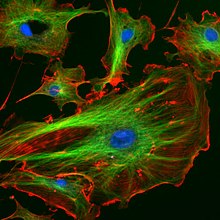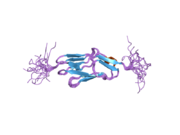Palladin
Palladin is a protein that in humans is encoded by the PALLD gene.[1][2][3][4] Palladin is a component of actin-containing microfilaments that control cell shape, adhesion, and contraction.[4]
Discovery
Palladin was characterised independently by two research groups, first in the lab of Carol Otey (in 2000)[2] and then in the lab of Olli Carpén (in 2001).[5] It is a part of the myotilin-myopalladin-palladin family and may play an important role in modulating the actin cytoskeleton.[6] Palladin, in contrast to myotilin and myopalladin, which are expressed only in striated muscle, is expressed ubiquitously in cells of mesenchymal origin.
Palladin was named after the Renaissance architect Andrea Palladio, reflecting its localization to architectural elements of the cell.[2]
 |
Isoforms
In humans, it appears that seven different isoforms exist, some of which arise through alternative splicing.[7] In mice, three major isoforms of palladin arise from a single gene. These isoforms contain between three and five copies (depending on the isoform) of an Ig-like domain and between one and two copies of a polyproline domain.[2]
Function
Palladin's precise biological role is poorly understood, but it has been shown to play a role in cytoskeletal organization, embryonic development, cell motility, scar formation in the skin, and nerve cell development.[6]
Disease linkage
Recently, it has been demonstrated that palladin RNA is overexpressed in patients with pancreatic neoplasia, and that palladin is both overexpressed and mutated in an inherited form of pancreatic cancer.[8] The palladin mutation identified in familial pancreatic cancer may be unique to a single North American family, as this same mutation has not been found in any other European or North American populations, respectively, in two other genetic studies.[9][10]
Further, Salaria et al. have shown that palladin is overexpressed in the non-neoplastic stroma of pancreatic cancer, but only rarely in the cancer cells per se,[11] suggesting that palladin's role in this disease may involve changes in the tumor microenvironmment. More research is clearly required before this protein and its role in neoplasia can be fully understood.
Disease-causing mutations have also been identified in the two other members of this gene family. Myotilin mutations cause a form of limb-girdle muscular dystrophy, and mutations in myopalladin cause an inherited form of heart disease (dilated cardiomyopathy).
Interactions
PALLD has been shown to interact with EZR.[5]
References
- ^ Nagase T, Ishikawa K, Suyama M, Kikuno R, Hirosawa M, Miyajima N, Tanaka A, Kotani H, Nomura N, Ohara O (Jul 1999). "Prediction of the coding sequences of unidentified human genes. XIII. The complete sequences of 100 new cDNA clones from brain which code for large proteins in vitro". DNA Res. 6 (1): 63–70. doi:10.1093/dnares/6.1.63. PMID 10231032.
{{cite journal}}: CS1 maint: multiple names: authors list (link) - ^ a b c d Parast MM, Otey CA (Sep 2000). "Characterization of Palladin, a Novel Protein Localized to Stress Fibers and Cell Adhesions". J Cell Biol. 150 (3): 643–56. doi:10.1083/jcb.150.3.643. PMC 2175193. PMID 10931874.
- ^ Wiemann S, Weil B, Wellenreuther R, Gassenhuber J, Glassl S, Ansorge W, Böcher M, Blöcker H, Bauersachs S, Blum H, Lauber J, Düsterhöft A, Beyer A, Köhrer K, Strack N, Mewes HW, Ottenwälder B, Obermaier B, Tampe J, Heubner D, Wambutt R, Korn B, Klein M, Poustka A (2001). "Toward a Catalog of Human Genes and Proteins: Sequencing and Analysis of 500 Novel Complete Protein Coding Human cDNAs". Genome Res. 11 (3): 422–35. doi:10.1101/gr.GR1547R. PMC 311072. PMID 11230166.
{{cite journal}}: CS1 maint: multiple names: authors list (link) - ^ a b "Entrez Gene: PALLD palladin, cytoskeletal associated protein".
- ^ a b Mykkänen OM, Grönholm M, Rönty M, Lalowski M, Salmikangas P, Suila H, Carpén O (2001). "Characterization of Human Palladin, a Microfilament-associated Protein". Mol. Biol. Cell. 12 (10): 3060–73. doi:10.1091/mbc.12.10.3060. PMC 60155. PMID 11598191.
{{cite journal}}: CS1 maint: multiple names: authors list (link) - ^ a b Otey CA, Rachlin A, Moza M, Arneman D, Carpen O (2005). "The palladin/myotilin/myopalladin family of actin-associated scaffolds". Int. Rev. Cytol. 246: 31–58. doi:10.1016/S0074-7696(05)46002-7. PMID 16164966.
{{cite journal}}: CS1 maint: multiple names: authors list (link) - ^ Rachlin AS, Otey CA (2006). "Identification of palladin isoforms and characterization of an isoform-specific interaction between Lasp-1 and palladin". J. Cell. Sci. 119 (Pt 6): 995–1004. doi:10.1242/jcs.02825. PMID 16492705.
- ^ Pogue-Geile KL, Chen R, Bronner MP, Crnogorac-Jurcevic T, Moyes KW, Dowen S, Otey CA, Crispin DA, George RD, Whitcomb DC, Brentnall TA (2006). "Palladin Mutation Causes Familial Pancreatic Cancer and Suggests a New Cancer Mechanism". PLoS Med. 3 (12): e516. doi:10.1371/journal.pmed.0030516. PMC 1751121. PMID 17194196.
{{cite journal}}: CS1 maint: multiple names: authors list (link) CS1 maint: unflagged free DOI (link) - ^ Slater E, Amrillaeva V, Fendrich V, Bartsch D, Earl J, Vitone LJ, Neoptolemos JP, Greenhalf W (2007). "Palladin Mutation Causes Familial Pancreatic Cancer: Absence in European Families". PLoS Med. 4 (4): e164. doi:10.1371/journal.pmed.0040164. PMC 1855695. PMID 17455999.
{{cite journal}}: CS1 maint: multiple names: authors list (link) CS1 maint: unflagged free DOI (link) - ^ Zogopoulos G, Rothenmund H, Eppel A, Ash C, Akbari MR, Hedley D, Narod SA, Gallinger S (2007). "The P239S palladin variant does not account for a significant fraction of hereditary or early onset pancreas cancer". Hum. Genet. 121 (5): 635–7. doi:10.1007/s00439-007-0361-z. PMID 17415588.
{{cite journal}}: CS1 maint: multiple names: authors list (link) - ^ Salaria SN, Illei P, Sharma R, Walter KM, Klein AP, Eshleman JR, Maitra A, Schulick R, Winter J, Ouellette MM, Goggins M, Hruban R (2007). "Palladin is Overexpressed in the Non-Neoplastic Stroma of Infiltrating Ductal Adenocarcinomas of the Pancreas, but is only Rarely Overexpressed in Neoplastic Cells". Cancer Biol. Ther. 6 (3): 324–8. doi:10.4161/cbt.6.3.3904. PMC 3144721. PMID 17404500.
{{cite journal}}: CS1 maint: multiple names: authors list (link)
Further reading
External links
- palladin+protein,+human at the U.S. National Library of Medicine Medical Subject Headings (MeSH)


